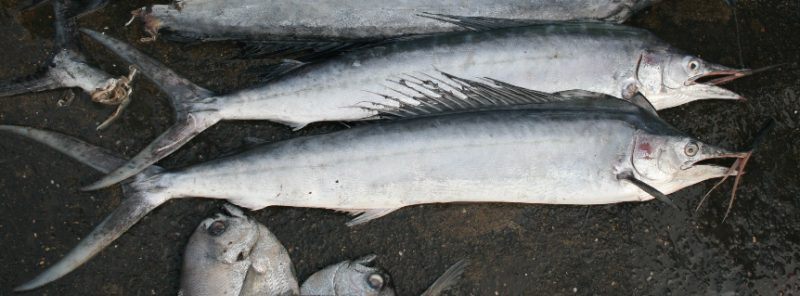Select the correct species. Click on image to enlarge.

Incorrect.
These are juvenile Istiompax indica.
Juvenile Istiompax indica can be identified by having a second dorsal fin anterior of second anal fin; pectoral fin rigid, sticking out away from body; 2 keels on caudal peduncle; branchiostegal frill long, extending to near level with rear edge of operculum; upper surfaces blackish to dark blue, silver below; lower jaw short and stocky, often turned downward at tip. A broken bill makes it difficult to determine its length (Istiompax indica have the stoutest bill), pelvic fin length cannot be deteremind as they are not visible (pelvic fins of Istiompax indica are narrow and long, but do not reach to near the anus). The high, sail-like first dorsal fin is a characteristic of juvenile Istiompax indica, vertical stripes (complete or partial) are also sometimes present in juveniles, such as in this example.
Incorrect.
These are juvenile Istiompax indica.
Juvenile Istiompax indica can be identified by having a second dorsal fin anterior of second anal fin; pectoral fin rigid, sticking out away from body; 2 keels on caudal peduncle; branchiostegal frill long, extending to near level with rear edge of operculum; upper surfaces blackish to dark blue, silver below; lower jaw short and stocky, often turned downward at tip. A broken bill makes it difficult to determine its length (Istiompax indica have the stoutest bill), pelvic fin length cannot be deteremind as they are not visible (pelvic fins of Istiompax indica are narrow and long, but do not reach to near the anus). The high, sail-like first dorsal fin is a characteristic of juvenile Istiompax indica, vertical stripes (complete or partial) are also sometimes present in juveniles, such as in this example.
Incorrect.
These are juvenile Istiompax indica.
Juvenile Istiompax indica can be identified by having a second dorsal fin anterior of second anal fin; pectoral fin rigid, sticking out away from body; 2 keels on caudal peduncle; branchiostegal frill long, extending to near level with rear edge of operculum; upper surfaces blackish to dark blue, silver below; lower jaw short and stocky, often turned downward at tip. A broken bill makes it difficult to determine its length (Istiompax indica have the stoutest bill), pelvic fin length cannot be deteremind as they are not visible (pelvic fins of Istiompax indica are narrow and long, but do not reach to near the anus). The high, sail-like first dorsal fin is a characteristic of juvenile Istiompax indica, vertical stripes (complete or partial) are also sometimes present in juveniles, such as in this example.
Correct!
These are juvenile Istiompax indica.
Juvenile Istiompax indica can be identified by having a second dorsal fin anterior of second anal fin; pectoral fin rigid, sticking out away from body; 2 keels on caudal peduncle; branchiostegal frill long, extending to near level with rear edge of operculum; upper surfaces blackish to dark blue, silver below; lower jaw short and stocky, often turned downward at tip. A broken bill makes it difficult to determine its length (Istiompax indica have the stoutest bill), pelvic fin length cannot be deteremind as they are not visible (pelvic fins of Istiompax indica are narrow and long, but do not reach to near the anus). The high, sail-like first dorsal fin is a characteristic of juvenile Istiompax indica, vertical stripes (complete or partial) are also sometimes present in juveniles, such as in this example.
Select the correct species. Click on image to enlarge.

Incorrect. This species is Thunnus obesus.
Thunnus obesus can be identified by having a deep rounded body; eyes large relative to head size and elliptical in shape; pectoral fins long and narrow, tips tapering to a thin point; posterior edge of caudal fin a smooth crescent shape; white/silver body markings in irregularly space, complete and broken vertical lines, sometimes confined to the lower portion of the body; finlets yellow with black posterior margin (markings fading when condition is lost).
Correct!
Thunnus obesus can be identified by having a deep rounded body; eyes large relative to head size and elliptical in shape; pectoral fins long and narrow, tips tapering to a thin point; posterior edge of caudal fin a smooth crescent shape; white/silver body markings in irregularly space, complete and broken vertical lines, sometimes confined to the lower portion of the body; finlets yellow with black posterior margin (markings fading when condition is lost).
Incorrect. This species is Thunnus obesus.
Thunnus obesus can be identified by having a deep rounded body; eyes large relative to head size and elliptical in shape; pectoral fins long and narrow, tips tapering to a thin point; posterior edge of caudal fin a smooth crescent shape; white/silver body markings in irregularly space, complete and broken vertical lines, sometimes confined to the lower portion of the body; finlets yellow with black posterior margin (markings fading when condition is lost).
Incorrect. This species is Thunnus obesus.
Thunnus obesus can be identified by having a deep rounded body; eyes large relative to head size and elliptical in shape; pectoral fins long and narrow, tips tapering to a thin point; posterior edge of caudal fin a smooth crescent shape; white/silver body markings in irregularly space, complete and broken vertical lines, sometimes confined to the lower portion of the body; finlets yellow with black posterior margin (markings fading when condition is lost).
Select the correct species. Click on image to enlarge.

Incorrect. This species is Alopias pelagicus.
Alopias pelagicus can be identified by having a strongly arched head profile between the eyes and by having no deep groves on the head. Other features of Alopias pelagicus not clearly visible on this individual include the upper caudal lobe nearly as long as rest of shark, the first dorsal-fin origin closer to pectoral-fin rear tip than pelvic-fin base and the moderately large eyes almost central on side of head.
Correct!
Alopias pelagicus can be identified by having a strongly arched head profile between the eyes and by having no deep groves on the head. Other features of Alopias pelagicus not clearly visible on this individual include the upper caudal lobe nearly as long as rest of shark, the first dorsal-fin origin closer to pectoral-fin rear tip than pelvic-fin base and the moderately large eyes almost central on side of head.
Incorrect. This species is Alopias pelagicus.
Alopias pelagicus can be identified by having a strongly arched head profile between the eyes and by having no deep groves on the head. Other features of Alopias pelagicus not clearly visible on this individual include the upper caudal lobe nearly as long as rest of shark, the first dorsal-fin origin closer to pectoral-fin rear tip than pelvic-fin base and the moderately large eyes almost central on side of head.
Incorrect. This species is Alopias pelagicus.
Alopias pelagicus can be identified by having a strongly arched head profile between the eyes and by having no deep groves on the head. Other features of Alopias pelagicus not clearly visible on this individual include the upper caudal lobe nearly as long as rest of shark, the first dorsal-fin origin closer to pectoral-fin rear tip than pelvic-fin base and the moderately large eyes almost central on side of head.
Select the correct species. Click on image to enlarge.

Incorrect. This species is Scomber australasicus.
Incorrect. This species is Scomber australasicus.
Nice job!
Incorrect. This species is Scomber australasicus.
Select the correct species. Click on image to enlarge.

Incorrect. This species is Tetrapturus angustirostris.
Tetrapturus angustirostris can be identified by having a short bill, only slightly longer than lower jaw and a flat to only slightly elevated nape. Other features of Tetrapturus angustirostris not clearly visible in this individual include the anterior portion of first dorsal fin taller than maximum body depth, posterior portion lower than maximum body depth; long pelvic fins, but not reaching to anus; anus located well forward of first anal fin by a distance greater than length of first anal-fin base; and 2 keels on either side of caudal peduncle.
Incorrect. This species is Tetrapturus angustirostris.
Tetrapturus angustirostris can be identified by having a short bill, only slightly longer than lower jaw and a flat to only slightly elevated nape. Other features of Tetrapturus angustirostris not clearly visible in this individual include the anterior portion of first dorsal fin taller than maximum body depth, posterior portion lower than maximum body depth; long pelvic fins, but not reaching to anus; anus located well forward of first anal fin by a distance greater than length of first anal-fin base; and 2 keels on either side of caudal peduncle.
Incorrect. This species is Tetrapturus angustirostris.
Tetrapturus angustirostris can be identified by having a short bill, only slightly longer than lower jaw and a flat to only slightly elevated nape. Other features of Tetrapturus angustirostris not clearly visible in this individual include the anterior portion of first dorsal fin taller than maximum body depth, posterior portion lower than maximum body depth; long pelvic fins, but not reaching to anus; anus located well forward of first anal fin by a distance greater than length of first anal-fin base; and 2 keels on either side of caudal peduncle.
Correct!
Tetrapturus angustirostris can be identified by having a short bill, only slightly longer than lower jaw and a flat to only slightly elevated nape. Other features of Tetrapturus angustirostris not clearly visible in this individual include the anterior portion of first dorsal fin taller than maximum body depth, posterior portion lower than maximum body depth; long pelvic fins, but not reaching to anus; anus located well forward of first anal fin by a distance greater than length of first anal-fin base; and 2 keels on either side of caudal peduncle.
Select the correct species. Click on image to enlarge.

Good job!
Auxis thazard can be identified by having a dorsal naked area that extends anterior of the pectoral-fin tip and a narrow posterior extension of the corselet being only 1–5 scales wide under origin of second dorsal fin.
Incorrect. This species is Auxis thazard.
Auxis thazard can be identified by having a dorsal naked area that extends anterior of the pectoral-fin tip and a narrow posterior extension of the corselet being only 1–5 scales wide under origin of second dorsal fin.
Incorrect. This species is Auxis thazard.
Auxis thazard can be identified by having a dorsal naked area that extends anterior of the pectoral-fin tip and a narrow posterior extension of the corselet being only 1–5 scales wide under origin of second dorsal fin.
Incorrect. This species is Auxis thazard.
Auxis thazard can be identified by having a dorsal naked area that extends anterior of the pectoral-fin tip and a narrow posterior extension of the corselet being only 1–5 scales wide under origin of second dorsal fin.
Select the correct species. Click on image to enlarge.

Correct!
This Istiompax indica can be identified by having pectoral fins sickle shaped, rigid and not able to be folded flat against body and branchiostegal frill long.
Incorrect. This species is Istiompax indica.
This Istiompax indica can be identified by having pectoral fins sickle shaped, rigid and not able to be folded flat against body and branchiostegal frill long.
Incorrect. This species is Istiompax indica.
This Istiompax indica can be identified by having pectoral fins sickle shaped, rigid and not able to be folded flat against body and branchiostegal frill long.
Incorrect. This species is Istiompax indica.
This Istiompax indica can be identified by having pectoral fins sickle shaped, rigid and not able to be folded flat against body and branchiostegal frill long.